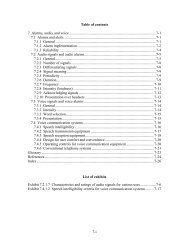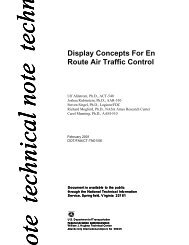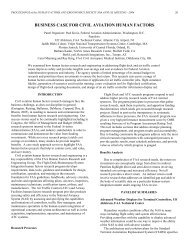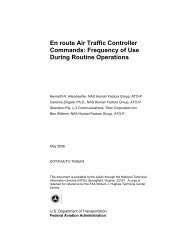Design of information Display Systems for Air Traffic Control - FAA
Design of information Display Systems for Air Traffic Control - FAA
Design of information Display Systems for Air Traffic Control - FAA
Create successful ePaper yourself
Turn your PDF publications into a flip-book with our unique Google optimized e-Paper software.
the users. We validated and refined the design concepts illustrated in the prototype with<br />
personnel from the field and developed an initial set <strong>of</strong> IDS design principles (Yuditsky &<br />
Friedman-Berg, 2003).<br />
In Phase 3, we evaluated the initial set <strong>of</strong> design principles <strong>for</strong> extensibility to the other ATC<br />
domains. We conducted field visits to two towers, three TRACONS, and three ARTCCs,<br />
interviewed 43 Specialists from terminal facilities and 20 Specialists from ARTCCs and<br />
observed their use <strong>of</strong> current IDSs. We also conducted workshops with field representatives to<br />
further evaluate the applicability and comprehensiveness <strong>of</strong> the set <strong>of</strong> principles. We identified<br />
domain differences and evaluated how the principles might be applied based on the needs <strong>of</strong> the<br />
different user populations. We then refined the initial set <strong>of</strong> principles to extend their<br />
applicability to all the ATC domains.<br />
3. RESULTS<br />
3.1 General Findings<br />
Our results indicate that terminal and en route Specialists use IDSs regularly to obtain<br />
operationally relevant <strong>in<strong>for</strong>mation</strong>. When asked to rate (on a 4-point scale where 1 is not at all<br />
and 4 is <strong>of</strong>ten) how frequently they use the IDS during a typical shift, en route Specialists rated<br />
their frequency <strong>of</strong> use as an average <strong>of</strong> 3.6 (SD = 0.7) and terminal Specialists rated their use a<br />
3.9 (SD = 0.3). FSS Specialists, who typically have limited access to their IDS, used a different,<br />
5-point rating scale to indicate frequency <strong>of</strong> use. They reported using the system a few to several<br />
times a day on average. Ratings from facilities with more IDS workstations were higher than<br />
those from facilities with only one or two displays (see Figure 1).<br />
5<br />
Mean Rating<br />
4<br />
3<br />
2<br />
1<br />
Rating Scale<br />
5 - Many Times per Day<br />
4 - Several Times per Day<br />
3 - A Few Times per Day<br />
2 - A Few Times per Week<br />
1 - A Few Times per Month<br />
0<br />
Millvile (2) St. Louis (*) ( a )<br />
Seattle (7) Sacramento (1) Oakland (1)<br />
Facility<br />
Figure 1. Ratings <strong>of</strong> IDS frequency <strong>of</strong> use.<br />
Note: The number <strong>of</strong> available displays is listed in parentheses.<br />
a St. Louis has an IDS at every position.<br />
The Specialists identified the primary purpose <strong>of</strong> the IDS as providing comprehensive<br />
<strong>in<strong>for</strong>mation</strong> in an efficient, easily accessible, automated <strong>for</strong>mat. This implies that they are using<br />
the IDSs in the field today as intended. Furthermore, the Specialists reported that what they like<br />
best about the systems is the fast access to <strong>in<strong>for</strong>mation</strong>, the variety <strong>of</strong> <strong>in<strong>for</strong>mation</strong> available in<br />
the system, and having the <strong>in<strong>for</strong>mation</strong> in an electronic <strong>for</strong>mat.<br />
4











